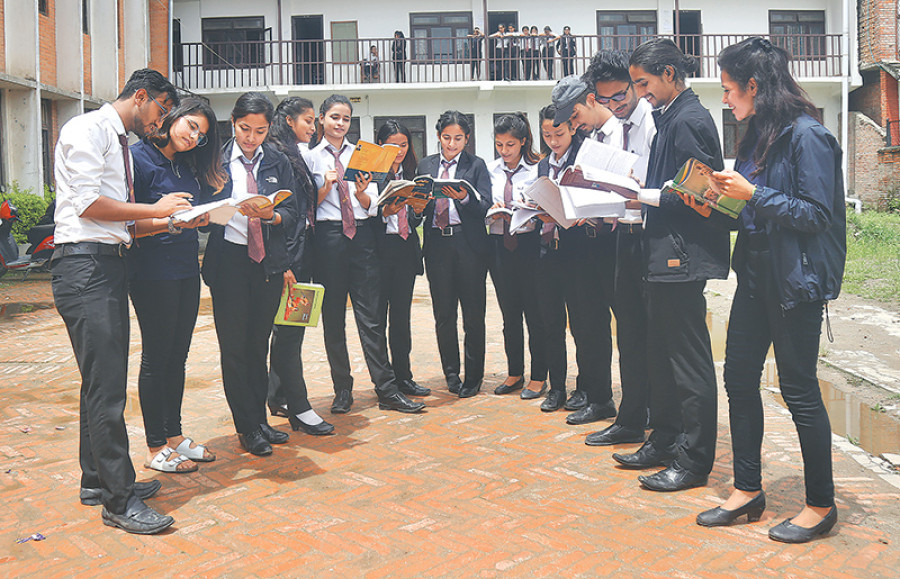Miscellaneous
By the law
As he waits for the finals results of his LLB programme, 26-year-old Yuvraj Bista is readying himself for the Public Service Commission (PSC) examination. Bista, who moved to Kathmandu from Achham a decade ago to pursue higher education, has always aspired to work for the government.
Sanjeev Giri
As he waits for the finals results of his LLB programme, 26-year-old Yuvraj Bista is readying himself for the Public Service Commission (PSC) examination. Bista, who moved to Kathmandu from Achham a decade ago to pursue higher education, has always aspired to work for the government.
Now, having acquired a degree in Law, in addition to the English and Sociology degrees he already holds, Bista feels he is primed to make the cut in the competitive PSC exams that draws thousands of aspirants from around the country.
Nineteen-year-old Jeena Basnet, a LLB aspirant at Nepal Law Campus, isn’t as sure footed. As a student who had ample reservations about taking up law initially, she now says that her trepidations are slowly waning. “At first I was very intimidated by the subject and about getting into a field that has historically been dominated by men,” she says, “But now that I see how broad the scope for a law degree is, I feel I’ve made the right choice.”
Bista and Basnet are among thousands of students who have enrolled into law schools around the country at a time when the popularity of legal education is one the rise once more. DN Parajuli, campus chief at Nepal Law Campus—Nepal’s first law school, believes that the increased popularity of law degrees is a result of the surge in demand for lawyers across the country.
“Law is one of the most bankable degrees because of its immense scope,” he says, “Graduates today are no longer limited to civil service or the courtroom and can explore options in I/NGOs, financial institutions, corporate houses and academia. That is why we have a lot of students pursuing law to supplement degrees they already hold. A working knowledge of the legal system is a plus point, regardless of what profession you’re engaged in.”
As a result, the Bhrikutimandap-based Nepal Law Campus, Parajuli says, has been witnessing a continuous rise in enrollment. The campus’ student-body has seen a double-digit growth in recent years—from students 3,300 in 2015 to north of 5,000 this academic calendar. The trend is similar at the Purvanchal University-affiliated Kathmandu School of Law and at Kathmandu University as well. And while five other campuses under the Tribhuvan University—located in Dharan, Rajbiran, Butwal, Pokhara and Dipayal—have only seen marginal gains, this, according to Parajuli, is because students still prefer to migrate to the Capital for higher education.
The surge in popularity of legal education, stakeholder say, is promising given that the country has been facing an acute shortage of lawyers in the past decade. Following a policy decision in 1996 that barred students from pursuing an intermediate degree in law (IL) right after the tenth grade, enrolment had seen a sharp decline. But now with three tiers of government in place, Parajuli believes that the need and scope for law graduates has vastly increased. “The provincial governments will have to draft their own laws and will need able personnel to efficiently execute them. We have even seen a surge of enrollment from municipal and elected officials as well,” he said.
But while the surge in popularity has been encouraging, questions over inadequate infrastructure and a Kathmandu-centric system, remains. According to Rajit Bhakta Pradhananga, a professor and former campus chief at Nepal Law Campus, if existing infrastructure aren’t upgraded to match the increase in the number of students, the quality of education being provided is bound to take a hit. “Government campuses don’t exactly have a good track record when it comes to infrastructure and the increase in enrollment will only increase the pressure on what is already a strained system,” he said.
As a solution, Parajuli believes that the Tribhuvan University should allow its other campuses in the Valley to offer law programmes in the short term, while improving the quality of education provided in its five colleges in the moffusil in the long-term.
Pradhananga, however, believes that there is reason for optimism not just because of the increase in number of students but also because the gender gap in legal education is being bridged. “That law used to be a completely male-dominated sector is no secret. But for the first time this year, we have more women students enrolled into the LLB program than men,” he said, “This is incredibly encouraging. With women like former justice Suhila Karki and Supreme Court justice Sapana Pradhan Malla continuing to break glass ceilings, the students have strong role models to look up to. And with women’s rights issues taking centre stage in the political process, the trend looks likely to continue in the
coming years. This bodes well not just for law as an academic pursuit and profession but how laws will be crafted and implemented in the future.”




 8.12°C Kathmandu
8.12°C Kathmandu










